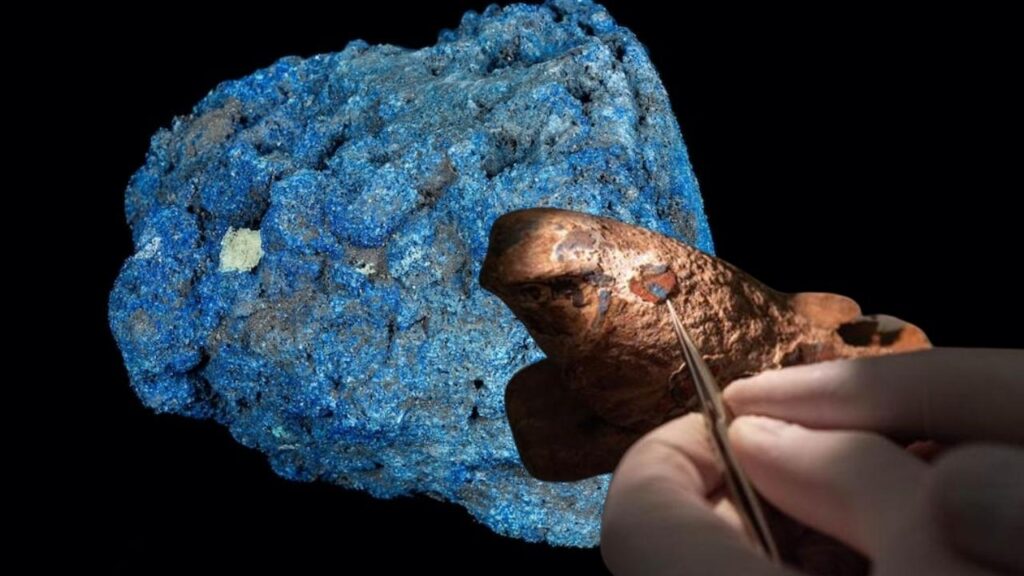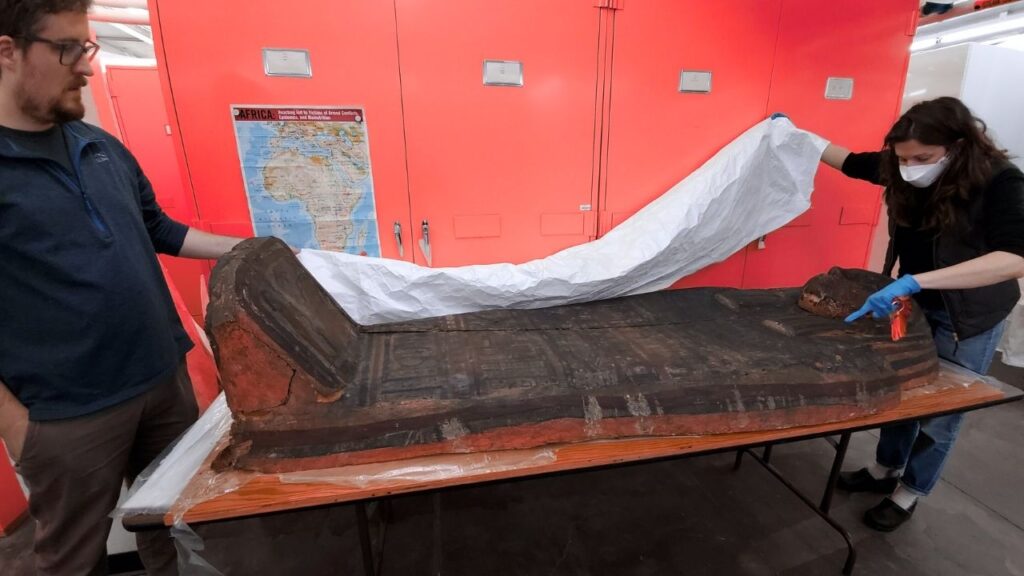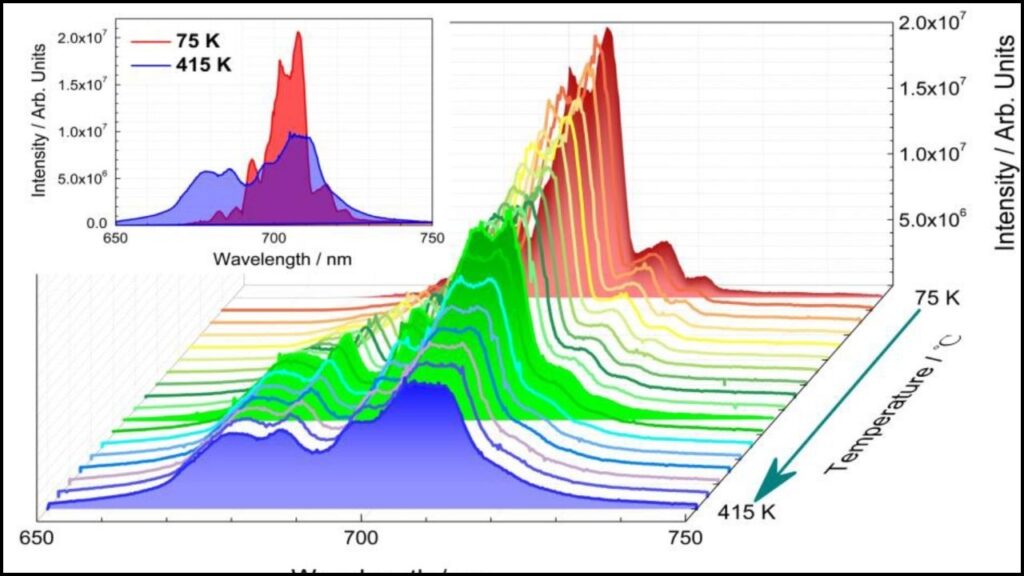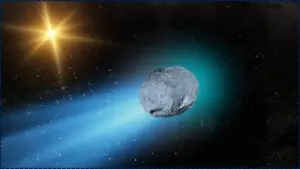Researchers Recreate Ancient Egyptian Blue Pigment With Modern Science: The recreation of ancient Egyptian blue pigment is a remarkable achievement that bridges the gap between history, archaeology, and cutting-edge science. Researchers at Washington State University have successfully reproduced Egyptian blue, a synthetic pigment dating back roughly 5,000 years, originally used by the ancient Egyptians to decorate tombs, statues, and artifacts. This pigment, known scientifically as calcium copper silicate (CaCuSi₄O₁₀), is recognized as the world’s oldest synthetic pigment and holds immense cultural and scientific importance.

By unraveling the secrets of this ancient pigment, scientists not only gain insight into the technological expertise of early civilizations but also discover innovative applications for the modern world — ranging from biomedical imaging to sustainable materials. In this article, we will explore the history, science, and potential of Egyptian blue in detail, offering practical understanding for both enthusiasts and professionals alike.
Table of Contents
Researchers Recreate Ancient Egyptian Blue Pigment With Modern Science
| Topic | Details |
|---|---|
| Pigment Name | Egyptian Blue |
| Scientific Name | Calcium Copper Silicate (CaCuSi₄O₁₀) |
| Estimated Age | Approximately 5,000 years |
| Primary Ingredients | Quartz (SiO₂), copper compounds, calcium carbonate, sodium carbonate |
| Ancient Use | Tomb paintings, statues, ceramics in ancient Egypt |
| Modern Uses | Biomedical imaging, infrared technologies, anti-counterfeiting inks, solar energy |
| Recreation Efforts | 12 distinct recipes replicated at Washington State University |
| Key Properties | Durable, stable color; emits near-infrared light |
| Research Collaborators | Carnegie Museum of Natural History, Smithsonian’s Museum Conservation Institute |
| Official Resource | Washington State University News |
The successful recreation of Egyptian blue pigment by modern scientists is a testament to human ingenuity spanning millennia. This synthetic pigment, first developed over 5,000 years ago, reveals much about ancient craftsmanship while opening doors to innovative, sustainable technologies in medicine, security, and energy. By understanding and harnessing this pigment’s unique properties, we celebrate the legacy of the past while lighting the way forward for science and industry.
What Is Egyptian Blue and Why Does It Matter?
Egyptian blue is widely regarded as the first synthetic pigment ever created by humans, with origins traced back to around 2500 BCE. The pigment’s distinctive vibrant blue color was prized in ancient Egypt, symbolizing the heavens, water, and the divine. It decorated the walls of tombs, funerary objects, and statues of deities and pharaohs, ensuring their connection to eternal life.
Chemically, Egyptian blue is calcium copper silicate, a crystalline compound made by heating a mixture of quartz (silica), copper compounds, calcium carbonate, and an alkali like sodium carbonate. Its remarkable stability means that many ancient Egyptian artworks still exhibit traces of this pigment after thousands of years.
Egyptian blue’s resilience and color-fastness surpass many natural pigments. Unlike organic dyes, it does not fade easily when exposed to light, humidity, or heat — a testament to the craftsmanship of ancient artisans.
The Scientific Journey to Recreate Egyptian Blue

The task to recreate Egyptian blue was led by Dr. Elisabeth Hausrath and her team at Washington State University. Their research aimed to not only replicate the pigment but also understand the precise manufacturing techniques used by ancient Egyptians.
Laboratory Analysis of Ancient Samples
The team began by analyzing microscopic samples from Egyptian artifacts housed in museums, including the Smithsonian and Carnegie Museum of Natural History. They employed sophisticated tools like:
- X-ray diffraction (XRD)
- Scanning electron microscopy (SEM)
- Energy-dispersive X-ray spectroscopy (EDS)
These analyses revealed the exact chemical composition, crystal structure, and particle size of Egyptian blue.
Experimental Recipes and Replication
The researchers devised 12 experimental recipes, adjusting the proportions of raw materials and varying the firing temperature and duration. The key ingredients typically included:
- Quartz sand (SiO₂): Provides silica for the silicate framework.
- Copper oxide (CuO): Responsible for the distinctive blue color.
- Calcium carbonate (CaCO₃): Acts as a flux and stabilizes the compound.
- Sodium carbonate (Na₂CO₃): Lowers the melting point, aiding the fusion of materials.
By heating these mixtures between 800°C and 1000°C for several hours, they synthesized pigments that closely matched the color and composition of historical samples. Interestingly, subtle changes in temperature and cooling rates produced different hues, from deep sapphire blues to paler turquoise and greenish shades.
“The variety of recipes and firing conditions hints at the artisans’ expertise in tailoring pigment properties for specific uses,” explained Dr. Hausrath.
Confirming Authenticity and Quality
The final synthesized pigments were compared with museum samples to confirm their authenticity. The team’s success provides robust evidence that ancient Egyptians had mastered a controlled ceramic synthesis technique millennia before modern chemistry.
What Makes Egyptian Blue Unique in Modern Science?
While Egyptian blue’s historical importance is well known, its properties have attracted renewed scientific interest because of its exceptional near-infrared (NIR) luminescence.
Near-Infrared Luminescence

When illuminated with visible light, Egyptian blue emits strong near-infrared light (wavelength ~910 nm). This phenomenon is rare among pigments and has practical applications:
- Biomedical Imaging: The NIR emission can penetrate biological tissues more effectively than visible light, aiding non-invasive imaging techniques used in detecting tumors or vascular diseases.
- Security and Anti-Counterfeiting: Invisible to the naked eye but detectable with special cameras, Egyptian blue can be used in secure inks and markings on currency, documents, and packaging.
- Optical Sensors and Telecommunications: Its stable luminescence could improve fiber optic technologies and photodetectors.
Environmental and Safety Advantages
Egyptian blue is made from abundant, non-toxic materials, making it a more environmentally friendly alternative to some modern pigments and dyes that contain hazardous heavy metals like cadmium or lead.
Moreover, its excellent durability means it can reduce the need for frequent repainting or reprocessing, contributing to sustainable conservation and manufacturing practices.
Detailed Guide: Making Egyptian Blue
For professionals interested in the practical aspects of Egyptian blue synthesis, here’s an expanded guide:
Ingredients and Their Roles
| Ingredient | Role | Common Sources |
|---|---|---|
| Quartz (SiO₂) | Provides silicon dioxide, forming the silicate framework | Silica sand, ground quartz |
| Copper Oxide (CuO) | Provides copper ions for blue coloration | Purchased reagent, copper salts |
| Calcium Carbonate (CaCO₃) | Flux that lowers melting temperature and stabilizes structure | Limestone, chalk |
| Sodium Carbonate (Na₂CO₃) | Flux that facilitates melting and fusion of ingredients | Natron, washing soda |
Equipment Needed
- High-temperature furnace or kiln (capable of 800°C to 1000°C)
- Crucibles resistant to high temperatures
- Safety equipment: gloves, goggles, ventilation
Step-by-Step Process
- Measure and Mix Ingredients: Combine silica, copper oxide, calcium carbonate, and sodium carbonate in precise ratios. Literature suggests ratios like 4:1:1:1 by weight, but variations are tested to achieve different hues.
- Heat the Mixture: Place the mix in a crucible and heat in the furnace. Typical firing temperature is between 900°C and 1000°C, maintained for 3 to 12 hours depending on recipe.
- Cooling: Cool the fused material slowly to allow crystal growth, which affects pigment quality.
- Grinding: Once cooled, the solidified mass is ground into a fine powder.
- Testing: The resulting pigment’s color and properties are tested against standards.
This detailed procedure allows replication of historical hues and properties but requires precise control of conditions and expertise.
Real-World Examples and Applications
Ancient Artifacts
Egyptian blue was used extensively in Egyptian tombs, such as:
- Tomb of Nebamun (British Museum, London): Murals with vivid blue pigments dating back over 3,000 years.
- Temple of Dendur (Metropolitan Museum of Art, New York): Stone carvings featuring blue paint still intact.
These artifacts demonstrate the pigment’s longevity and cultural significance.
Modern Science and Industry
- Biomedical Imaging: Researchers at Lawrence Berkeley National Laboratory are investigating Egyptian blue for non-invasive imaging applications due to its strong NIR emission. (LBL Research)
- Anti-Counterfeiting: Its unique luminescent properties are being developed into invisible security inks that improve product authentication.
- Solar Energy: Egyptian blue’s interaction with infrared light is being studied for potential use in improving the efficiency of solar panels.
- Museum Conservation: The pigment’s synthetic recreation allows accurate restoration of artifacts without relying on potentially harmful or mismatched materials.
New 3D Textile Material Designed to Improve Mobility and Comfort in Wearable Tech
FAQs About Researchers Recreate Ancient Egyptian Blue Pigment With Modern Science
1. Why did ancient Egyptians create Egyptian blue instead of using natural blue pigments?
Natural blues like lapis lazuli were rare and expensive. Egyptian blue could be manufactured locally in larger quantities, offering durability and vibrant color.
2. Is Egyptian blue safe for modern use?
Yes. It is made from non-toxic minerals and is considered safe for various applications, unlike some modern synthetic pigments containing heavy metals.
3. Can Egyptian blue be used in modern paint or cosmetics?
While promising, its industrial use is still under research. The pigment’s particle size and infrared properties require careful formulation to ensure safety and performance in products.
4. How does Egyptian blue differ from other synthetic pigments?
It is unique in its chemical composition and the ability to emit near-infrared light, a feature rare among pigments.
5. Are there other ancient synthetic pigments?
Yes, but Egyptian blue is the earliest known synthetic pigment. Others, like Han blue from ancient China, appeared later.



















